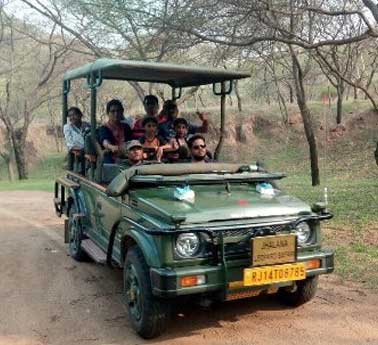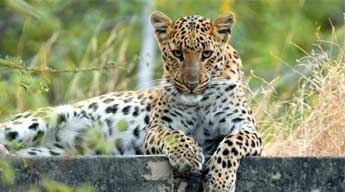Amagarh Leopard Safari
Embarking on an Amagarh Leopard Safari promises an enchanting journey into the heart of India's wilderness, where the majestic leopards reign supreme amidst stunning landscapes and diverse ecosystems.
Nestled in the rugged terrain of the Aravalli Hills in Rajasthan, Amagarh Leopard Safari offers a unique wildlife experience characterized by its pristine natural beauty and abundant leopard population. As you venture into this picturesque sanctuary, you'll be greeted by a tapestry of rocky outcrops, lush forests, and cascading waterfalls, providing the perfect backdrop for thrilling wildlife encounters.


One of the defining features of Amagarh Leopard Safari is its remarkable leopard population. The sanctuary is home to a significant number of leopards, making it an ideal destination for wildlife enthusiasts and photographers seeking to observe these elusive predators in their natural habitat. Unlike other reserves where leopard sightings may be rare, Amagarh's high leopard density increases the likelihood of memorable encounters, allowing visitors to witness these magnificent creatures up close in their natural environment.
The safari experience at Amagarh is enhanced by its diverse wildlife population. In addition to leopards, the sanctuary is inhabited by a wide array of fauna, including sambar deer, spotted deer, langurs, and various bird species. This diversity adds depth to the safari experience, offering opportunities to observe and appreciate the intricate web of life that thrives within the sanctuary's boundaries.
Accessibility is another advantage of choosing Amagarh Leopard Safari. Located in close proximity to major cities such as Udaipur and Jaipur, the sanctuary is easily accessible, making it an ideal destination for both domestic and international travelers. Whether you're embarking on a day trip from Jaipur or including Amagarh in your Rajasthan itinerary, you'll find that reaching the sanctuary is convenient and hassle-free, allowing you to maximize your time spent in the wilderness.
Amagarh Leopard Safari is not just about wildlife; it also offers a glimpse into Rajasthan's rich cultural heritage. Surrounding the sanctuary are quaint villages and historical sites that provide insights into the region's traditions and history. Visitors can immerse themselves in the local culture by interacting with villagers, exploring ancient temples, or partaking in traditional festivities, adding a cultural dimension to their safari experience.
Conservation lies at the heart of Amagarh Leopard Safari's ethos. The sanctuary is dedicated to the preservation of its natural heritage and works tirelessly to protect its resident wildlife and their habitats. Conservation initiatives include anti-poaching patrols, habitat restoration projects, and community outreach programs aimed at fostering harmony between humans and wildlife. By choosing to visit Amagarh, visitors indirectly contribute to these conservation efforts, supporting the sanctuary's mission of safeguarding Rajasthan's biodiversity for future generations.
For photography enthusiasts, Amagarh Leopard Safari offers unparalleled opportunities to capture stunning images of wildlife and landscapes. Whether you're capturing the grace of a leopard in motion, the vibrant hues of a sunset over the Aravalli Hills, or the intricate details of indigenous flora and fauna, Amagarh provides a wealth of subjects to inspire your creativity.
QUICK FACTS ABOUT AMAGARH LEOPARD RESERVE
Location Situated in the rugged terrain of the Aravalli Hills, Amagarh Leopard Reserve is located in Rajasthan, India.
Leopard Population The reserve boasts a significant population of leopards, making it an ideal destination for wildlife enthusiasts.
Biodiversity Apart from leopards, Amagarh is home to a diverse array of fauna, including sambar deer, spotted deer, langurs, and various bird species.
Accessibility The reserve is easily accessible from major cities such as Udaipur and Jaipur, making it a convenient destination for travelers.
Cultural Heritage Surrounding the sanctuary are quaint villages and historical sites, offering insights into Rajasthan's rich cultural heritage.
Conservation Efforts Amagarh is dedicated to preserving its natural heritage through initiatives such as anti-poaching patrols, habitat restoration, and community outreach programs.
Photography Opportunities The picturesque landscapes and abundant wildlife of Amagarh provide excellent opportunities for wildlife photography.
Pristine Natural Beauty The sanctuary's rugged terrain, lush forests, and cascading waterfalls create a picturesque backdrop for safari adventures.
Day Trips and Tours Visitors can embark on day trips or include Amagarh in their Rajasthan itinerary to experience the sanctuary's wildlife and natural beauty.
Sustainable Tourism By visiting Amagarh Leopard Reserve, travelers indirectly support conservation efforts and contribute to the sustainable development of the region.
Frequently Asked Questions
Where is the Amagarh Leopard Reserve located?
The Amagarh Leopard Reserve is situated in [insert location here], known for its diverse wildlife and specifically for its population of leopards.
What is the significance of the Amagarh Leopard Reserve?
The reserve plays a crucial role in the conservation of leopards and other wildlife species in the region. It serves as a protected habitat for these animals, helping to maintain biodiversity and ecological balance.
How large is the Amagarh Leopard Reserve?
The reserve spans an area of [insert size here], providing ample space for the leopards and other wildlife to roam freely.
What other wildlife can be found in the Amagarh Leopard Reserve?
Apart from leopards, the reserve is home to a variety of wildlife including deer, wild boars, various species of birds, and smaller mammals.
Are there any accommodations available within or near the reserve?
Yes, there are accommodations available both within the reserve and in nearby areas to facilitate tourists and wildlife enthusiasts who wish to explore the reserve.
What activities can visitors engage in at the Amagarh Leopard Reserve?
Visitors can enjoy wildlife safaris, nature walks, birdwatching, and photography tours within the reserve. There are also educational programs and guided tours available to learn more about the flora and fauna of the region.
Is it safe to visit the Amagarh Leopard Reserve?
The reserve is well-managed with trained staff and guides to ensure the safety of visitors. However, it's important to follow the rules and guidelines provided by the authorities to minimize any risks associated with wildlife encounters.
When is the best time to visit the Amagarh Leopard Reserve?
The best time to visit the reserve is typically during the winter months (November to February) when the weather is pleasant, and wildlife sightings are more frequent.
How can one reach the Amagarh Leopard Reserve?
The reserve is accessible by road from nearby cities and towns. Visitors can also avail of guided tours and transportation services offered by local tour operators.
Is there an entry fee for the Amagarh Leopard Reserve?
Yes, there is usually an entry fee for visitors to the reserve, which helps support conservation efforts and maintenance of the area.

